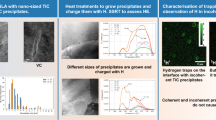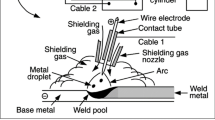Abstract
Microalloy precipitate alterations (particularly dissolution) in the heat-affected zone (HAZ) of a Grade 100 steel, microalloyed by titanium, niobium, and vanadium and produced in the form of a plate with a thickness of 8 mm, was examined both theoretically and experimentally. For theoretical analysis of precipitate dissolution, pairs of effective peak temperature and holding time were extracted from the thermal cycles of welding, and were superimposed on the Ashby and Easterling non-equilibrium solubility curves for different fractions of precipitate dissolution. Intersections between the effective T–t curves and the non-equilibrium solubility curves gave critical pairs of effective peak temperature and holding time for dissolution of different fractions of a precipitate, which resulted in the establishment of precipitate dissolution profiles in the HAZ. Experimental analysis of precipitate alterations was carried out using carbon extraction replicas in a transmission electron microscope. The theoretical analyses were in agreement with experimental results, showing that it is the dissolution of small Nb-rich particles that paves the way to grain growth in the coarse-grained HAZ. Reprecipitation was generally suppressed in the low heat-input weld sample. There was some reprecipitation in the higher heat-input weld samples. Coarsening of TiN did not occur in the HAZ, due to the large size of these particles in the steel examined.









Similar content being viewed by others
References
DeArdo AJ (1995) Modern thermomechanical processing of microalloyed steel: a physical metallurgy perspective. Iron & Steel Society, Pittsburgh, p 15
Tanaka T (1995) Science and technology of hot rolling process of steel. Iron & Steel Society, Pittsburgh, p 165
Pereloma EV, Bayley C, Boyd JD (1996) Mater Sci Eng A 210(1–2):16
Gladman T (1997) The physical metallurgy of microalloyed steels. The Institute of Materials, London
Poorhaydari K, Ivey DG (2009) Can Metall Q 48(4):443
Poorhaydari K, Ivey DG (2009) Can Metall Q 48(2):115
DeArdo AJ (2003) Int Mater Rev 48(6):371
Ashby MF, Easterling KE (1982) Acta Metall 30(11):1969
Ion JC, Easterling KE, Ashby MF (1984) Acta Metall 32(11):1949
Easterling KE (1992) Introduction to the physical metallurgy of welding. Butterworth-Heinemann Ltd, Oxford
Poorhaydari K (2005) Microstructure and property examination of weld HAZ in Grade 100 microalloyed steel. Ph.D. Thesis, University of Alberta, Edmonton, Canada
Poorhaydari K, Patchett BM, Ivey DG (2005) Estimation of cooling rate in the welding of plates with intermediate thickness. Weld J 84(10):149-s–155-s
Ruhle M (1995) In: ASM handbook vol 9. Metallography and microstructures. ASM International, Materials Park, OH, p 103
Poorhaydari K, Ivey DG (2007) Mater Charact 58(6):544
Suzuki S, Weatherly GC (1985) In: Gray JM, Ko T, Zhang SH, Wu BR, Xie XS (eds) Characterization of precipitates and grain growth in simulated HAZ thermal cycles of Ti–Nb bearing steel weldments. ASM International, China, p 675
Agren J (1990) Scand J Metall 19(1):2
Andersen I, Grong O (1995) Acta Metall Mater 43(7):2673
Shome M, Sarma DS, Gupta OP, Mohanty ON (2003) ISIJ Int 43(9):1431
Moon J, Jeong H, Lee J, Lee C (2008) Mater Sci Eng A 483–484:633
Moon J, Lee C (2009) Acta Mater 57(7):2311
Wang HR, Wang W (2009) J Mater Sci 44(2):591. doi:10.1007/s10853-008-3069-0
Fossaert C, Rees G, Maurickx T, Bhadeshia HKDH (1995) Metall Mater Trans A 26A(1):21
Palmiere EJ, Garcia CI, Ardo AJD (1994) Metall Mater Trans A 25(2):277
Liao FC, Liu S, Olson DL (1994) Effect of titanium nitride precipitates on the weldability of nitrogen enhanced Ti–V microalloyed steels. Iron and Steel Society, Inc., Pittsburgh, Pennsylvania, p 511
McGurk TE, Speer JG, Matlock DK (2007) Mater Sci Technol 6:347
Hulka K, Heisterkamp F (1998) Mater Sci Forum 284–286:343
Dolby RE (1983) Met Technol 10(9):349
Collins LE, Klein R, Bai D (2009) Can Metall Q 48(3):261
Acknowledgements
The authors wish to thank the Natural Sciences and Engineering Research Council (NSERC) of Canada and Evraz Inc. NA for financial support and steel plates (Evraz).
Author information
Authors and Affiliations
Corresponding author
Rights and permissions
About this article
Cite this article
Poorhaydari, K., Ivey, D.G. Precipitate alterations in the heat-affected zone of a Grade 100 microalloyed steel. J Mater Sci 46, 4953–4963 (2011). https://doi.org/10.1007/s10853-011-5412-0
Received:
Accepted:
Published:
Issue Date:
DOI: https://doi.org/10.1007/s10853-011-5412-0




